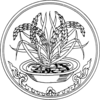Ang Thong province
This article has multiple issues. Please help improve it or discuss these issues on the talk page. (Learn how and when to remove these template messages)
|
Ang Thong
อ่างทอง | |
|---|---|
|
| |
 Map of Thailand highlighting Ang Thong Province | |
| Country | Thailand |
| Capital | Ang Thong town |
| Government | |
| • Governor | Wirawut Puttraserani (since October 2015) |
| Area | |
| • Total | 968.4 km2 (373.9 sq mi) |
| • Rank | Ranked 71st |
| Population (2014) | |
| • Total | 283,568 |
| • Rank | Ranked 67th |
| • Density | 290/km2 (760/sq mi) |
| • Rank | Ranked 12th |
| Time zone | UTC+7 (ICT) |
| ISO 3166 code | TH-15 |
Ang Thong (Thai: อ่างทอง, pronounced [ʔàːŋ tʰɔ̄ːŋ]) is one of the central provinces (changwat) of Thailand. The name "Ang Thong" means "gold basin", thought to have derived from the basin-like geography of the area, and the golden color of the rice grown in the region.
Neighboring provinces are (from north clockwise) Sing Buri, Lopburi, Ayutthaya, and Suphanburi.
Ang Thong native handicrafts include moulded court dolls, firebrick, and wickerwork.
There are more than 200 temples in Ang Thong.[citation needed]
Geography
Ang Thong occupies a low river plain, created by the Chao Phraya and the Noi Rivers. It has neither mountains nor forests, but consists of mostly agricultural land. The two rivers, together with many canals (khlongs), provide enough water for rice farming.[1]
History
Ang Thong was historically known as Wiset Chai Chan, on the Noi River. It was an important border town of the Ayutthaya Kingdom during the wars with Burma, as the Noi River served as a natural obstacle for advancing troops.
During the reign of King Taksin after the fall of Ayutthaya, the main city of the province was moved to the Chao Phraya River, and named Ang Thong, as the Noi River had become silted and too shallow for transportation.
Ang Thong is the provenance of Li Ke, the native folk song, and the hometown of Nai Dok and Nai Thongkaeo, two heroes of the Bang Rachan Battle.
Symbols
The provincial seal shows some golden ears of rice in a bowl of water. This symbolizes the fertility of province as one of the major producers of rice. The provincial tree is the Gaub Tree (Diospyros malabarica).
Administrative divisions

The province is divided into seven districts (amphoe). The districts are further subdivided into 81 communes (tambon) and 513 villages (muban).
References
- ^ "Ang Thong". Tourism Authority of Thailand (TAT). Retrieved 14 October 2016.
External links
 Ang Thong travel guide from Wikivoyage
Ang Thong travel guide from Wikivoyage- Ang Thong provincial map, coat of arms and postal stamp
- Flag of Ang Thong Province

